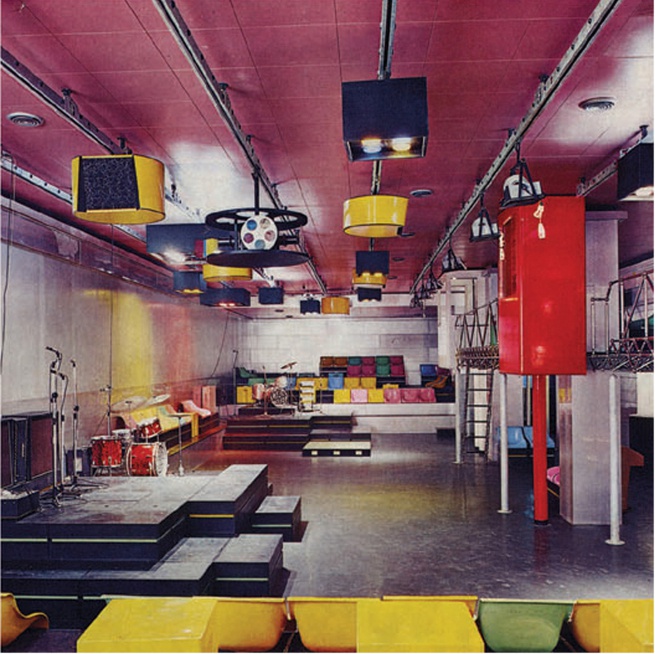In Pictures: The radical Italian discos of the '60s and '70s
- Text by HUCK HQ

The 1960s and 1970s were a brief period of clubbing utopia in Italy where a wave of radical architecture groups started transforming spaces in an ideological way.
The era, brought to life in a new show at the ICA London: Radical Disco: Architecture and Nightlife in Italy, 1965-1975 until January 10, featured experimental architecture groups such as Gruppo 9999, Superstudio and UFO who were bored with postwar modern design and wanted to create something that would make clubbers think, as opposed to escape.

The stage and audio-visual system inside La Fine del Mondo, designed by Pietro Derossi, Giorgio Ceretti and Riccardo Rosso, Turin, 1966. © Pietro Derossi

Interior of La Fine del Mondo, designed by Pietro Derossi, Giorgio Ceretti and Riccardo Rosso, Turin, 1966. ©Pietro Derossi
An early inspiration for some of the designers in the show was Carlo Mollino’s Le Roi Dancing in Turin. According to design journalist Alice Rawsthorn: “A dancehall, rather than a disco, Le Roi Dancing was built from scratch in an old scrap metal yard in 1959 by a local impresario Attilio Lutrario, who commissioned Mollino to design the interior. Known as the “dark prince” of mid-20th century Italian design, Mollino worked mostly in Turin with a crew of trusted local artisans. Like all of his projects, Le Roi combined colour, form and light to dramatic effect.”

Carlo Mollino’s Le Roi Dancing in Turin
One of the stand-out clubs in the exhibition is Bamba Issa in Forte de Miami by architect Titti Maschietto whose father bought a villa in the area and renovated it into a hotel. Maschietto decided it was the perfect place for UFO to put their theories into practice. According the Guardian: “Bamba Issa took its inspiration from a Disney comic book, Donald Duck and The Magic Hourglass, which UFO felt was “an allegory for capitalism, its arrogance and shortcomings”. The club’s design reflected the comic’s look: it had large lanterns, hourglass-shaped furniture, a DJ booth apparently on a flying carpet.”

UFO, lovers on a swing chair, Bamba Issa, Forte dei Marmi, 1970. Photograph by Carlo Bachi, © Lapo Binazzi, UFO Archive.

UFO, amphibious camels returning to Africa, Bamba Issa, Forte dei Marmi, 1969. Photograph by Carlo Bachi, © Lapo Binazzi, UFO Archive.
Co-curated by Dr Catharine Rossi and Sumitra Upham, Radical Disco drops at the ICA London at a time when nightclubs are closing across the UK and the idea of clubs as important cultural spaces needs some serious consideration.
Radical Disco: Architecture and Nightlife in Italy, 1965-1975 is at the ICA London until January 10.
You might like

Huck teams up with Eastern Margins for a special SXSW London showcase
From Shibuya to Shoreditch — Taking place at Village Underground on Monday, performances will come from MONO, Nina Utashiro, Ena Mori, Jianbo, LVRA & Soda Plains.
Written by: Isaac Muk

Analogue Appreciation: Shura
I Got Too Sad For My Friends — In an ever more digital, online world, we ask our favourite artists about their most cherished pieces of physical culture. Today, it’s English singer-songwriter Shura.
Written by: Shura

After Assad’s fall, Syria’s musicians rebuild from the rubble
Spaces Between the Beats — Following decades of dictatorship and 14 years of civil war, the country’s classical and creative scenes have an opportunity to build from scratch. Andrei Popviciu speaks to the people hoping for a flourishing new era of art and sound.
Written by: Andrei Popoviciu

At Belgium’s Horst, electronic music, skate and community collide
More than a festival — With art exhibitions, youth projects and a brand new skatepark, the Vilvoorde-Brussels weekender is demonstrating how music events can have an impact all year round.
Written by: Isaac Muk

Tony Njoku: ‘I wanted to see Black artists living my dream’
What Made Me — In this series, we ask artists and rebels about the forces and experiences that shaped who they are. Today, it’s avant-garde electronic and classical music hybridist Tony Njoku.
Written by: Tony Njoku

Block9 reveals its Glastonbury Festival 2025 plans
Party and protest — The nightlife hub will feature a bigger-than-ever Saturday daytime block party across The NYC Downlow and Genosys, and a huge collaboration with artist-activist group Led By Donkeys.
Written by: Isaac Muk

